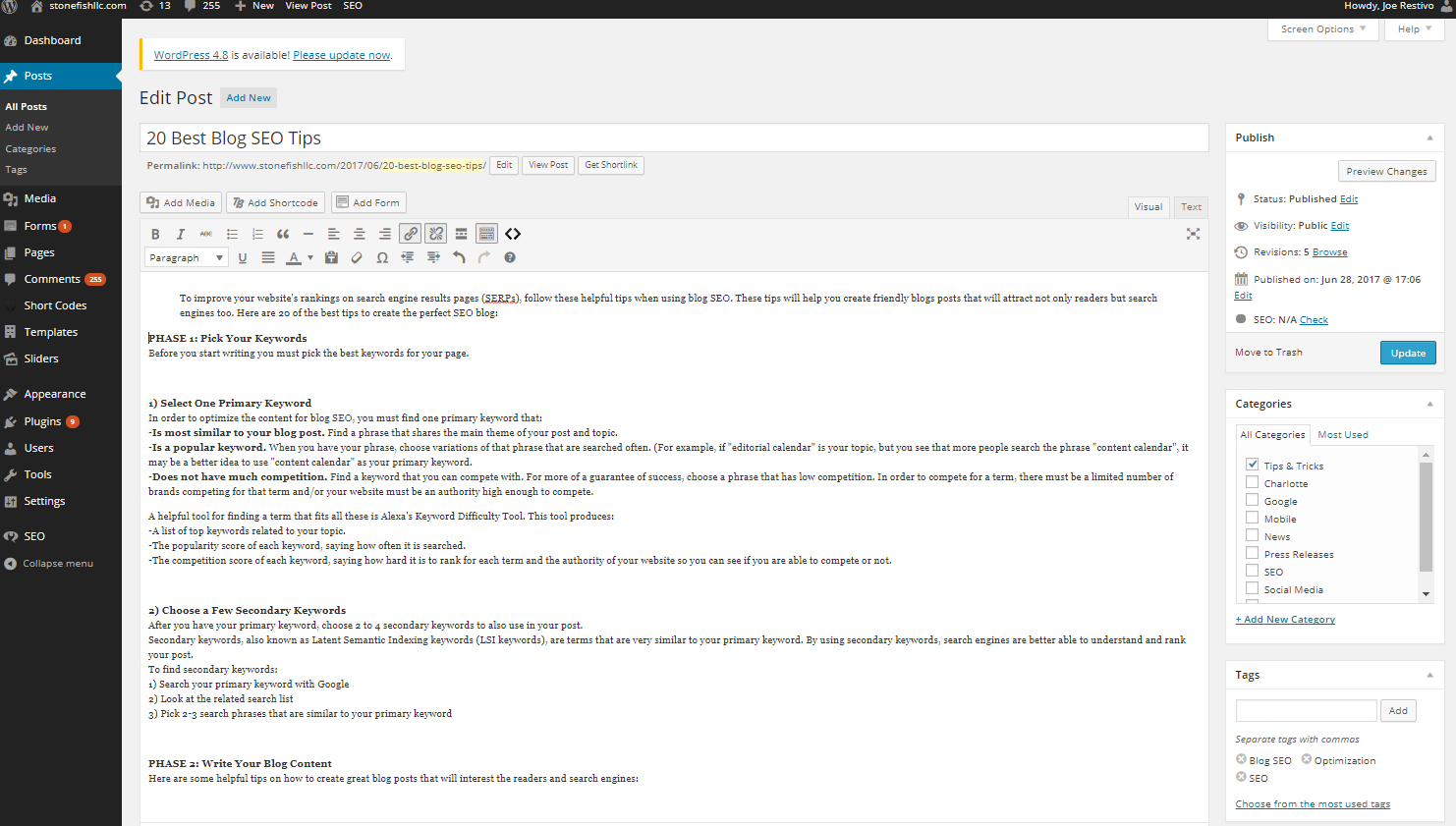20 Tips for Writing SEO Friendly Blog Posts
Why Your SEO Campaigns Are Failing
May 31, 2017
Top 9 SEO Things to Consider When Creating a New Website
June 28, 2017To improve your website’s rankings on search engine results pages (SERPs), follow these helpful tips when using blog SEO. These tips will help you create friendly blogs posts that will attract not only readers but search engines too. Here are 20 of the best tips to create the perfect SEO blog…
PHASE 1: Pick Your Keywords
Before you start writing you must pick the best keywords for your page.
1) Select One Primary Keyword
In order to optimize the content for blog SEO, you must find one primary keyword that:
- Is most similar to your blog post. Find a phrase that shares the main theme of your post and topic.
- Is a popular keyword. When you have your phrase, choose variations of that phrase that are searched often. (For example, if “editorial calendar” is your topic, but you see that more people search the phrase “content calendar”, it may be a better idea to use “content calendar” as your primary keyword.
- Does not have much competition. Find a keyword that you can compete with. For more of a guarantee of success, choose a phrase that has low competition. In order to compete for a term, there must be a limited number of brands competing for that term and/or your website must be an authority high enough to compete.
A helpful tool for finding a term that fits all these is Alexa’s Keyword Difficulty Tool. This tool produces:
- A list of top keywords related to your topic.
- The popularity score of each keyword, saying how often it is searched.
- The competition score of each keyword, saying how hard it is to rank for each term and the authority of your website so you can see if you are able to compete or not.
2) Choose a Few Secondary Keywords
After you have your primary keyword, choose 2 to 4 secondary keywords to also use in your post.
Secondary keywords, also known as Latent Semantic Indexing keywords (LSI keywords), are terms that are very similar to your primary keyword. By using secondary keywords, search engines are better able to understand and rank your post.
To find secondary keywords:
1) Search your primary keyword with Google
2) Look at the related search list
3) Pick 2-3 search phrases that are similar to your primary keyword
PHASE 2: Write Your Blog Content
Here are some helpful tips on how to create great blog posts that will interest the readers and search engines:
3) Write For Readers, Not Search Engines
Keep in mind that although you are writing for search engines, you are still actually writing for humans. The best way to appeal to search engines is to first appeal to the readers. That so, keep your readers in mind and try not to make changes if they will improve SEO but decrease user experience.
4) Write a Minimum of 300 Words
Using more than 300 words is very helpful for search engines to be able to understand the page and rank it better. There are many different opinions on what the perfect word count is, but for best practice, make sure you write enough to cover your topic by keeping it around 500 and 2,500 words. If you exceed that though, it may be best to break up the text into multiple, linked pages.
5) Use the Primary Keyword Naturally Throughout the Text
When you place the primary keyword throughout the text it helps the search engines understand and categorize the post. A good keyword should be about 2% of your post, so try to place it naturally 1 or 2 times every 100 words.
6) Use the Secondary Keywords Once Throughout the Text
Place 2 or 4 secondary keywords throughout the text at least once in order to provide additional context for your content that will help search engines further categorize the text.
7) Incorporate the Primary Keyword in the First Paragraph
Writing the primary keyword close to the top of the page and in the first paragraph is a very good idea for your post.
8) Use the Primary Keyword in the Subheading
A subheading is formatted with H2, H3, H4, and so on. It’s purpose is to create a break in the page. It is used in the best SEO content to break up the big blocks of text. It makes it much easier for readers to read the content online and for search engines to understand the copy. Use the primary keyword in at least one of your subheadings.
9) Use the Keyword Toward the Bottom of the Page
When your ending your post, you should include the primary keyword. It creates a conclusion that helps define the overall post.
10) Write Original Content
In order to increase the SEO power of your website, you must write original content. Search engines are not a fan of copied content.
11) Make Sure Content is Grammatically Correct
Both search engines and readers will appreciate well-written content. Most importantly, search engines rank pages using signals form their grammar and spelling. Make sure you double check for any errors.
12) Write at an Eighth-Grade Reading Level
The more successful blog posts are easy to comprehend and will be appreciated by the readers and search engines. Therefore, try to use short sentences and paragraphs.
13) Include Inbound Links
Inbound links are hyperlinks to posts/pages that are on your website. They are necessary because they help search engines lead the readers to the information needed. Make sure that when you add inbound links that you use anchor text that is similar to the keyword of the page you are linking to.
14) Include Outbound Links
Outbound links are hyperlinks to posts/pages that are on another website. These links are used to organize information in your content and lead readers to your content. Be sure to use these links naturally throughout your post when talking about ideas from other websites.
PHASE 3: Optimize Your Post
After writing all your content, improve your blog SEO by optimizing these things:
15) Use the Primary Keyword in Title Page
The title page is the actual name of the page that readers see. Incorporate the primary keyword into the title and try to put it toward the beginning.
16) Add the Primary Keyword in the Permalink
A permalink is the unique part of the URL that comes after the main domain or sub-domain for each website. In order to have a SEO-friendly URL, incorporate the primary keyword as the majority of the URL.
17) Add the Primary Keyword in the SEO Title
The SEO title is a secondary title for the page that is visible on search engine results pages. The SEO title should incorporate the primary keyword and be a maximum of 55 characters.
18) Use the Primary Keyword in the Metal Description
A meta description is a description of the website that adds more backend information for the search engine crawlers. The text is usually visible on search engine results pages, which helps readers choose which results they want. Create a meta description for each blog page that incorporates the primary keyword and is a maximum of 155 characters.
19) Assign Appropriate Categories & Tags
Tags and categories organize the blog posts on a website. You can assign categories and tags to the pages to link them to certain topics and themes. If done right, they can boost your site’s SEO. Create a strong system by assigning one or two categories to each post and choosing tags that best describe the post.
20) Use the Primary Keyword in Image ALT Tags
Images make your post look more appealing and reliable to readers and search engines. Therefore, add at least one image in your blog post. When adding the image, make sure you use the primary keyword in the image “alt tag” which will appear to search engine crawlers.
Don’t fall behind the new SEO trends and improve your blog SEO with these 20 easy yet helpful tips!






